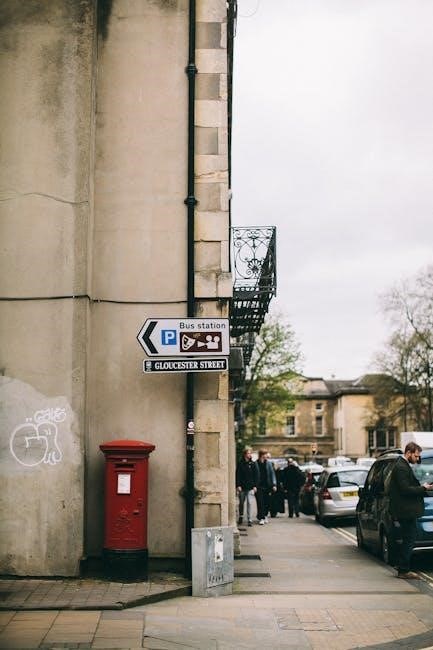Welcome to Oxford, a city steeped in history and academia! A self-guided walking tour offers the perfect way to explore its iconic landmarks, colleges, and hidden gems at your own pace. Discover the charm of this world-renowned university city, from famous Harry Potter filming locations to breathtaking architecture, all while enjoying the freedom to create your own adventure.
Why Choose a Self-Guided Tour?
A self-guided walking tour of Oxford offers unparalleled flexibility, allowing you to explore at your own pace and tailor your experience to your interests. Whether you’re passionate about history, architecture, or Harry Potter filming locations, this approach lets you prioritize what matters most to you. It’s also cost-effective and provides the freedom to linger at favorite spots or skip less appealing ones. With downloadable maps and guides readily available, you can easily navigate Oxford’s iconic landmarks and hidden gems independently, creating a personalized adventure that suits your style and schedule.
Benefits of Exploring Oxford at Your Own Pace
Exploring Oxford at your own pace allows for a more immersive and personalized experience. You can linger at iconic landmarks, delve deeper into historical sites, or skip less interesting spots without being rushed. This flexibility ensures a more enjoyable and memorable journey. Additionally, self-guided tours are often cost-effective, giving you the freedom to allocate your time and resources as you see fit, making your Oxford adventure truly unique and tailored to your preferences.

Preparing for Your Self-Guided Walking Tour
Plan your itinerary, check attraction schedules, wear comfy shoes, and start early to maximize your Oxford exploration and make the most of your self-guided adventure.
Essential Items to Bring Along
Wear comfortable footwear for walking, bring a reusable water bottle, and pack lightweight, weather-appropriate clothing. Carry a portable charger, snacks, and a camera for capturing memories. Don’t forget a map, guidebook, or downloaded GPS route. Include a small first-aid kit, travel-sized umbrella, and some cash for unexpected purchases. A backpack or cross-body bag will help keep everything organized and accessible during your Oxford adventure. Stay prepared to enjoy a seamless and enjoyable self-guided tour experience.
Downloading Maps and Guides
Download detailed maps and guides beforehand to navigate Oxford effortlessly. Use apps like Google Maps or Visit Oxfordshire for interactive routes. Offline access ensures connectivity in areas with limited Wi-Fi. Look for guides highlighting key landmarks, historical insights, and themed walking routes. Many colleges and museums offer free downloadable brochures. Ensure your device is fully charged, and consider printing a backup map. This preparation will help you make the most of your self-guided walking tour experience in Oxford.
Understanding Oxford’s Layout and Landmarks
Oxford’s historic city center is compact, with colleges, chapels, and iconic buildings clustered together. The city is divided into quarters, each reflecting its medieval roots. Landmarks like the Bodleian Library and Ashmolean Museum serve as navigational aids. Riverside paths along the Thames and Cherwell offer scenic routes. Familiarize yourself with key streets like High Street and Broad Street, which connect many attractions. This layout allows visitors to explore effortlessly, blending academic and cultural highlights seamlessly.

Popular Routes for a Self-Guided Tour
Oxford offers scenic and historic walking routes, including the Classic Oxford University Tour, Historic Colleges and Quadrangles, and a picturesque walk across iconic bridges.
The Classic Oxford University Tour
Embark on a journey through Oxford’s iconic academic landmarks, starting at the Bodleian Library. Wander past the Radcliffe Camera and Brasenose College, soaking in the historic atmosphere. Stroll through the charming streets, admiring the Sheldonian Theatre and the Ashmolean Museum. This route offers a glimpse into Oxford’s intellectual heart, blending stunning architecture with rich history. Perfect for first-time visitors, it captures the essence of the city’s scholarly heritage and its timeless charm.
Exploring Historic Colleges and Quadrangles
Oxford’s colleges are renowned for their stunning quadrangles and historic architecture. Visit Christ Church, famous for its Tom Tower, and Merton College, one of the oldest. Wander through Magdalen College’s picturesque cloisters and admire the serene surroundings. Each quadrangle offers a glimpse into centuries of academic tradition. Take your time to explore hidden chapels, gardens, and intricate stonework. These spaces reflect the city’s scholarly heritage and provide a peaceful retreat from the bustling streets.
A Walking Route Through Oxford’s Iconic Bridges
Oxford’s iconic bridges are a must-see on any self-guided tour. Start at the Bridge of Sighs, a Gothic-style bridge connecting Hertford College. Nearby, Magdalen Bridge offers stunning views of the River Cherwell. Don’t miss the High Bridge, one of Oxford’s oldest bridges, and Folly Bridge, with its charming riverside setting. These bridges showcase the city’s architectural beauty and provide perfect spots for photos. Stroll along the riverbanks and enjoy the scenic views while exploring these historic landmarks.

Must-See Attractions in Oxford
Oxford’s must-see attractions include the historic Bodleian Library, stunning Christ Church College, and world-renowned Ashmolean Museum, each offering unique insights into the city’s rich history and culture.
The Bodleian Library and Its History
The Bodleian Library, founded in 1602 by Sir Thomas Bodley, is one of Europe’s oldest and largest libraries. As the University of Oxford’s main research library, it holds over 13 million items, including rare manuscripts and ancient texts. Its stunning architecture, such as the iconic Radcliffe Camera and Duke Humfrey’s Library, attracts visitors worldwide. The library is a legal deposit repository, preserving every book published in the UK. Its rich history and scholarly significance make it a must-visit on any Oxford tour.
Christ Church College and Cathedral
Christ Church College, founded in 1532 by Cardinal Thomas Wolsey and refounded by Henry VIII, is one of Oxford’s largest and most prestigious colleges. It is also home to the Cathedral Church of Christ, the seat of the Bishop of Oxford. Visitors can explore its stunning architecture, including the Tom Tower and historic cloisters. The college’s grandeur and rich history, combined with its picturesque surroundings like Christ Church Meadow, make it a highlight of any self-guided walking tour in Oxford.
The Ashmolean Museum
The Ashmolean Museum, established in 1683, is the oldest public museum in the UK. It houses over 850,000 objects spanning archaeology, art, and history. Highlights include Egyptian mummies, Michelangelo’s drawings, and ancient Greek pottery. The museum’s rooftop restaurant offers stunning views of Oxford. A must-visit for history enthusiasts, the Ashmolean provides a rich cultural experience, making it a standout attraction on any self-guided walking tour of Oxford.
Harry Potter Filming Locations in Oxford
Oxford’s iconic architecture served as a backdrop for the Harry Potter films. Fans can explore magical scenes and relive movie moments during their self-guided walking tour;
Christ Church College’s Staircase
Christ Church College’s grand staircase is a must-visit for Harry Potter fans. Featured in the first film, it’s where Professor McGonagall transforms into a cat. The staircase’s ornate details and historical charm make it a standout location. Visitors can climb the stairs, imagining themselves in the wizarding world. A fun fact: the staircase is still used by students and staff today, blending magic with real-life academia during your self-guided walking tour of Oxford.
The Bodleian Library’s Divinity School
The Bodleian Library’s Divinity School is a breathtaking space featured in the Harry Potter films as the Hogwarts infirmary. Its stunning medieval architecture, including a vaulted ceiling, transports visitors to another era. As part of the Bodleian Library, this historic room is a must-see for both book lovers and movie fans. During your self-guided walking tour, take a moment to admire its intricate details and soak in the atmosphere of one of Oxford’s most iconic locations.
New College Cloisters
New College Cloisters, another Harry Potter filming location, offers a serene atmosphere perfect for reflection. The cloisters’ elegant medieval architecture and tranquil courtyard provide a peaceful escape from the bustling city. As part of your self-guided tour, admire the intricate stonework and stained-glass windows. This historic site is not only a filming location but also a significant part of Oxford’s academic heritage, making it a must-visit for both movie enthusiasts and history buffs alike.

Oxford’s Hidden Gems
Discover Oxford’s lesser-known treasures, such as the Oxford Castle & Prison, offering a glimpse into the city’s rich history. Stroll through charming, lesser-known gardens tucked away in the city’s historic core.
The Eagle and Child Pub
The Eagle and Child Pub, affectionately known as “The Bird and Baby,” is a historic gem nestled in the heart of Oxford. Famous for being the regular meeting spot of literary giants like J.R.R. Tolkien and C.S. Lewis, this charming pub is steeped in intellectual history. Its cozy atmosphere, complete with a roaring fireplace and wooden paneling, offers a perfect retreat for visitors to enjoy a pint or coffee while soaking in the city’s rich cultural legacy.
The Museum of Oxford
The Museum of Oxford, located in the heart of the city, offers a fascinating glimpse into Oxford’s rich history and development. Housed in the Town Hall, the museum showcases exhibits spanning from prehistoric times to the modern era. Highlights include artifacts from the Domesday Book, Oxford’s medieval history, and even a marmalade-making display. Interactive exhibits make it engaging for all ages, providing a deeper understanding of the city’s cultural and social evolution over the centuries.
The Oxford Botanic Garden
The Oxford Botanic Garden, established in 1621, is one of the oldest botanic gardens in Europe. It boasts over 8,000 plant species, including rare and exotic flora. The garden features stunning glasshouses, a rock garden, and a bog garden, showcasing diverse plant habitats. A peaceful retreat from the city, it offers a chance to relax and learn about plant conservation. Its proximity to Oxford’s historic center makes it a perfect addition to any self-guided walking tour, blending nature and knowledge seamlessly.

Cultural and Historical Insights
Oxford’s rich history and cultural heritage are evident in its medieval architecture, world-renowned university, and vibrant arts scene, offering a unique glimpse into centuries of intellectual and artistic growth.
Oxford’s Medieval Architecture
Oxford’s medieval architecture is a testament to its rich history, with structures like the University Church of St Mary and Christ Church Cathedral showcasing stunning Gothic designs. The intricate stone carvings, pointed arches, and ribbed vaults reflect the craftsmanship of the medieval period. Many colleges, such as Merton and Brasenose, retain their original medieval features, offering a glimpse into Oxford’s academic and religious past. These buildings highlight the city’s enduring legacy as a center of learning and spiritual significance.

The Role of the University in the City’s History
The University of Oxford, founded in the 12th century, has shaped the city’s identity as a hub of learning and intellectual discovery. It attracted scholars and thinkers, fostering a culture of innovation and debate. Over centuries, the university’s growth influenced Oxford’s economy, architecture, and social fabric. Today, it remains central to the city’s heritage, preserving traditions while driving modern advancements. Its legacy is evident in the city’s academic and cultural vibrancy, making it a cornerstone of Oxford’s history and identity.
Notable Alumni and Their Contributions
Oxford’s esteemed alumni have left indelible marks on literature, science, and politics. J.R.R. Tolkien and C.S. Lewis, renowned authors, drew inspiration from Oxford’s academic environment. Stephen Hawking revolutionized cosmology during his time here. Leaders like Tony Blair and Bill Clinton studied at Oxford, shaping global affairs. Their contributions highlight the university’s role in nurturing brilliance. Walking through Oxford, visitors can trace the footsteps of these luminaries, connecting with the city’s intellectual and cultural legacy.

Practical Tips for Your Tour
Wear comfortable shoes, check the weather, and carry a reusable water bottle. Bring a map or guide to navigate Oxford’s historic streets easily and efficiently.
Opening Hours and Admission Fees
Most Oxford colleges and museums operate between 10 AM and 5 PM, but hours vary by location and season. Check official websites for specific timings and closures. Admission fees range from £5 to £15 for colleges like Christ Church and Magdalen. Some attractions, such as the Ashmolean Museum, offer free entry, while others require pre-booked tickets. Consider purchasing a combined ticket for multiple sites to save money. Plan your itinerary accordingly to avoid missing popular spots during peak times.
Navigating Oxford’s Cobbled Streets
Oxford’s cobblestone streets are charming yet challenging to navigate. Wear sturdy footwear, as the uneven surfaces can be slippery, especially when wet. The city’s narrow, winding lanes can feel like a maze, but getting lost is part of the adventure. Carry a map or use GPS to stay on track. Be mindful of pedestrian-only zones and shared spaces with cyclists. Respect the historic environment and other walkers to ensure a pleasant experience for everyone. Enjoy the journey through Oxford’s timeless streets!
Respecting College Grounds and Rules
When exploring Oxford’s colleges, respect the rules and private spaces. Many areas are accessible to visitors, but some remain restricted. Always follow signage, stay on designated paths, and avoid restricted zones. Photography may be limited in certain areas, and silence is appreciated in libraries and chapels. Remember, these are working academic and residential environments. Adhering to rules ensures a positive experience for both visitors and the college community. Your consideration helps preserve these historic spaces for future generations.

Bonus Tips for First-Time Visitors
Plan ahead, wear comfy shoes, and carry a map. Start early to avoid crowds, and consider free walking guides from the tourist information center. Enjoy!
Where to Grab a Bite or Drink
Oxford offers charming spots for refreshments. The Eagle and Child, famous for its literary history, is perfect for a pint or meal. The Grand Café, one of England’s oldest coffeehouses, serves delightful treats. For quick bites, Pret a Manger and Costa Coffee are convenient. Don’t miss The Natural Bakery for fresh pastries or The Folly for riverside dining. These spots provide ideal breaks during your self-guided tour, blending history with modern convenience.
Photography Opportunities
Oxford is a photographer’s paradise, with its iconic architecture and picturesque settings. Capture the grandeur of the Bodleian Library and the intricate details of college buildings. The Bridge of Sighs and Radcliffe Camera are must-shoot landmarks. Don’t miss the charming riverside paths along the Cherwell and the vibrant atmosphere of High Street. Seasonal blooms in college gardens and historic market scenes add unique perspectives. Snap iconic shots of Oxford’s skyline from vantage points like St Mary’s Church tower for unforgettable memories.
Seasonal Events and Festivals
Oxford comes alive with seasonal events that add charm to your self-guided walking tour. Summer brings the Oxfordshire County Show, showcasing local traditions and crafts. Autumn features the Oxford Lieder Festival, celebrating classical music. Winter highlights festive markets and twinkling lights along the High Street. Spring blooms with cultural festivals and vibrant college garden displays. Time your visit to coincide with these events for a unique and memorable experience, blending history, culture, and seasonal beauty into your exploration of Oxford.

Day Trips and Extensions
Extend your Oxford adventure with a visit to nearby Blenheim Palace, a UNESCO World Heritage Site. Explore its grand gardens and historical significance, then discover charming Cotswolds villages or scenic Chiltern Hills for picturesque walks and quaint village charm.
A Short Walk to Port Meadow
Port Meadow, a vast open space just a 20-minute walk from Oxford’s city center, offers a peaceful escape. This historic grazing land, mentioned in the Domesday Book, features scenic views of the River Thames. Walkers can enjoy spotting wildlife, exploring the meadow’s natural beauty, and discovering Bronze Age burial mounds. Perfect for a picnic or a relaxing stroll, Port Meadow provides a serene contrast to Oxford’s bustling academic atmosphere, making it an ideal extension to your self-guided tour.
Visiting Nearby Blenheim Palace
Blenheim Palace, a UNESCO World Heritage Site, is a grand day-trip destination from Oxford. Birthplace of Winston Churchill, this opulent estate boasts stunning State Rooms, exquisite gardens, and the Churchill Exhibition. Located just 8 miles from Oxford, it’s easily accessible by bus or bike. Visitors can explore the palace’s rich history, stroll through the landscaped park, or enjoy a picnic by the lake. Combine your visit with a stop in the charming village of Woodstock for a quintessential English experience.